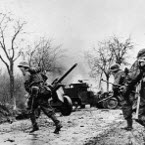One thing that srikes me is the extremely large supply capabilities of (especially) the German forces - (In fact I expect this applies to the Western Allies as well, but have less material at hand to check the correct force sizes/supply strength).
It isn't so much that the strength in men/trucks is too high, but those actively responsible for supply distribution and movement only form a relatively lean force:
From the western desert a PzD has only 12 supply columns and a supply 'company'. This comprises:
a single POL column (size unspecified, but I assume equivalent to a heavy column?)
4 heavy columns, each 60 tonnes payload
7 light columns, each 30 tonnes payload
200-230 men in a work company for unloading/transferring cargo.
Total payload, for ammunition and basics supply, 450 tonnes.
Regimental supply is at most a single light column, and the integral capacity of the trucks held at company/battalion echelons - something on the order of 40 tonnes?
By comparison, the full supply capacity of the COTA units is:
Div Base - 828 tons (stocks 1023 tons)
Pz Regt Base - 162 tons (stocks 87 tons)
Schtz Regt Base - 166 tons (stocks 82 tons)
This is 230% of what looks to be a 'correct' level of supply.
I have experimented within the test scenarios with the supply echelon at 44% for Divisional supply (mot), and 30% for Regimental supply (mix of (mot) and straight infantry division regimental supply columns), and apart from the smaller unit footprints and staggering of supply arrivals over a longer period (each Regt column must make more than one trip if there has been rapid movement or heavy combat to service all companies) there seems to be little real difference so long as contact with Army/Offmap supply is retained.
I see a requirement for the Regt Base to be within the vicinity of the Regt combat arms to allow rapid replenishment, whereas the AI leaves Regt bases in the far rear, and pushes the Div Base forwards?
Having less than 50% of the ability to store and move supplies does discourage constant use of all the artillery on hand though, as this requires the entire supply lift to sustain
Need to still look at Allied supply, but my gut feeling is there is just too much here also - possibly the vast bulk of the rear echelon should be non-supply troops (signals, cooks, band, chaplain, graves, hospital etc).
It would be useful if the supply echelon could be made appropriately sized, but to acquire the ability to replace losses sustained from other non-combat arms, perhaps with a loss of efficiency if the replacements exceed a reasonable proportion of strength?







